John Wolff's Web Museum
The "Celestina" Organette
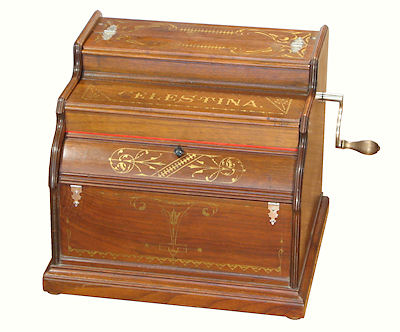 The 20-note "Celestina" organette was produced by the Munroe Organ
Reed Company and mass-marketed by the Mechanical Orguinette Company
(later The Aeolian Organ and Music Company) during the 1880s and 90s.
The same or similar instruments were produced and sold by several
other companies in the USA and England. In 1885 the Mechanical
Orguinette Company alone sold over 10,000 Celestinas at a list price
of $25 each, or about $2000 in today's money.
The 20-note "Celestina" organette was produced by the Munroe Organ
Reed Company and mass-marketed by the Mechanical Orguinette Company
(later The Aeolian Organ and Music Company) during the 1880s and 90s.
The same or similar instruments were produced and sold by several
other companies in the USA and England. In 1885 the Mechanical
Orguinette Company alone sold over 10,000 Celestinas at a list price
of $25 each, or about $2000 in today's money.
The 20-note organette is a considerable improvement over the
14-note instruments, both
mechanically and musically. Rather than using the paper tune sheet
as a valve to admit air to the reeds, the Celestina uses a set of
conventional reed-organ pallet valves operated by tiny pneumatic
motors (miniature bellows), which in turn are operated by much smaller
holes in the tune sheet. The more complex mechanism allows the
20 notes to be recorded on a paper roll that is only 5-1/2" wide.
The rolls are wound on compact wooden spools, and are easily
interchanged. The tune catalogue includes a very broad selection
of traditional, religious, operatic, popular, music-hall, and
military songs.
Here are some short MIDI files which show several quite different
styles of 20-note organette arrangements. The sound you hear will
depend on how well your computer plays the MIDI "reed organ" patch.
Listen to:
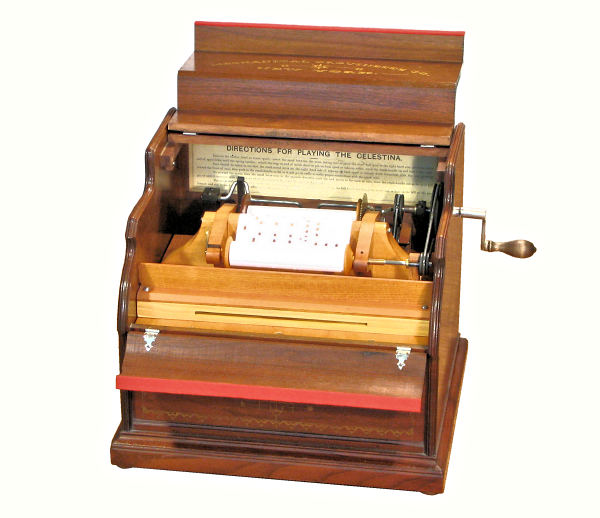 Celestina with doors open.
Celestina with doors open.
The Celestina is a much larger and more substantial instrument
than the 14-note organettes. The solid timber case measures 16" wide,
14" deep, and 14" high, and the instrument as a whole weighs just
on 20 pounds. The case is decorated with elaborate gold linework on
all sides.
The upper section of case opens as shown to install the music
roll. The small curved door at the front is normally held closed by a
light spring, but can be drawn open to vary the volume while playing.
An instruction label is pasted onto the inside of the back, so that
it is visible when changing the roll.
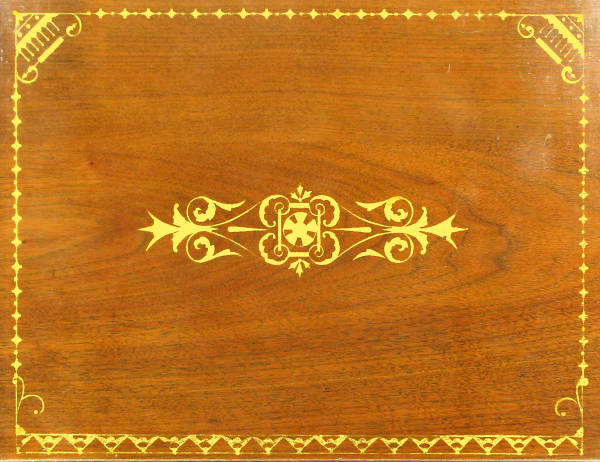 Celestina decoration 1.
Celestina decoration 1.
The Celestina casework was extensively decorated with elaborate
gold linework in a variety of geometric patterns.
This (slightly enhanced) illustration shows one common form of
decoration on the back panel. The central motif is repeated on the
side panels, with even more elaborate borders. The front and top of
the case are decorated in a similar style.
 Celestina decoration 2.
Celestina decoration 2.
The Celestina name is printed on the outside of the top door
in a large decorated font with elaborate borders.
 Celestina decoration 3.
Celestina decoration 3.
The Mechanical Orguinette Company name is printed on the inside
of the top door in a very distinctive font. Later models show the
name of the Aeolian Organ and Music Company.
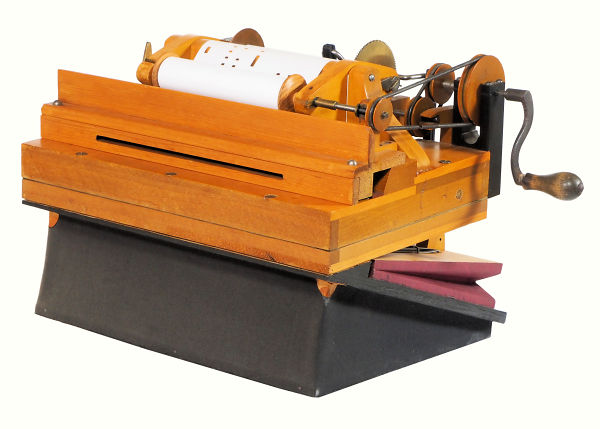 Celestina mechanism - front view
Celestina mechanism - front view
This view shows a Celestina mechanism removed from its case. The
black bellows at the bottom form the suction reservoir or "equaliser".
The reservoir is held open by two strong (8lb) internal springs, and
closes as the air is pumped out by the red pumping bellows (or
"exhausters") at the rear. A relief valve is provided on the underside
of the reservoir.
The shallow rectangular box above the reservoir is the windchest,
containing the pallet valves and their operating pneumatics. The
top surface of windchest forms the soundboard. The block containing
the 20 reeds is mounted to the top of the soundboard, just behind
the cover strip with the long horizontal slot.
The music roll clips into place at the front of the transport
mechanism. The paper passes from the underside of the roll, over a
"tracker bar" which reads the holes, then onto the underside of the
take-up spool at the rear.
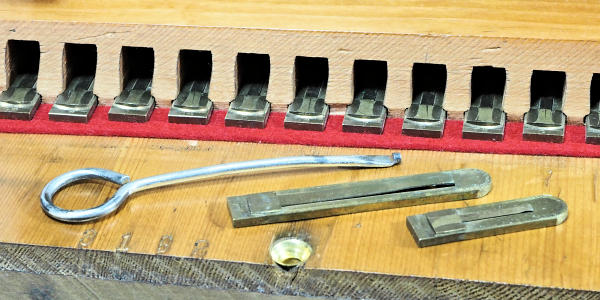 Celestina reed block and reeds
Celestina reed block and reeds
This view shows part of the wooden block which holds the 20 brass
reeds. The reed cells are individually sized and shaped to suit the
pitch of the note. The lowest and highest reeds are shown removed
at the front. To the left is a "reed hook" for withdrawing the reeds
from their cells. The reed hook is supplied with the machine, and is
normally held in a wooden clip on the left-hand side of the spoolbox.
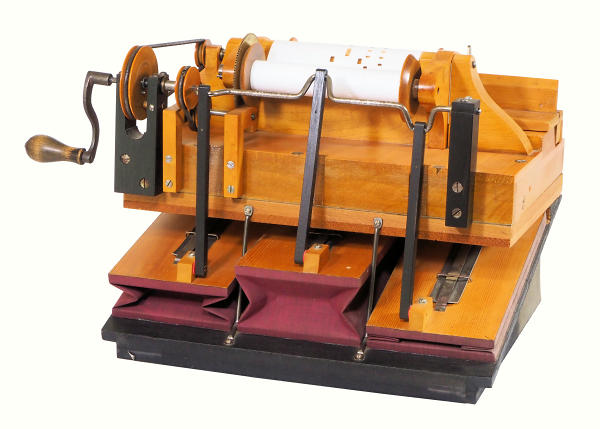 Celestina mechanism - rear view
Celestina mechanism - rear view
This rear view shows the three pumping bellows or "exhausters" and
their connection to the crankshaft. Two metal stays pass between the
exhausters to support the rear of the windchest. At the upper left
is the roll drive and rewind mechanism.
To play the Celestina, the winding handle is pushed inwards to
engage with the crankshaft, and is turned clockwise at a constant rate.
The normal cranking speed is about 120 RPM, or 2 turns per second. The
crankshaft operates the exhausters to supply the suction, and pulls
the tune sheet onto the take-up spool via a spring-belt drive and an
intermediate gear.
To re-wind the roll, the take-up spool is first lifted away from
the driving gear, either by turning a small eccentric lever on the
driving side of the take-up spool, or by tilting the entire transport
mechanism in some later models. The winding handle is then pulled
outwards to engage with the large rewind pulley and the long spring
belt at the far left. The handle is again turned clockwise to wind
the roll back onto the original spool.
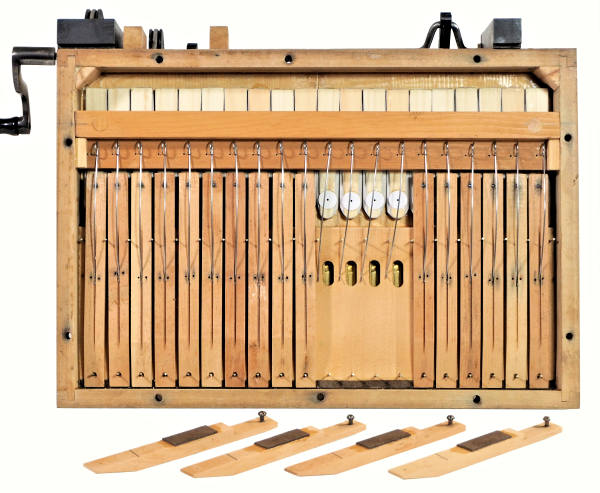 Inside the Celestina windchest.
Inside the Celestina windchest.
Rather than using the paper tune sheet as a valve to admit air to
the reeds, the Celestina uses conventional reed-organ pallet valves
operated by tiny pneumatic bellows. This view of the inside of the
windchest shows the 20 long pallet valves and their torsion springs.
Four of the pallets have been removed to show the operating
pneumatics. The pallet pneumatics are 3-1/2" long and 5/8" wide, and
open to 1/2". Much of the length of the pneumatic is hidden under
the bar which supports the pallet springs. Four of the reeds are
visible through the round-ended slots in the soundboard.
The windchest is normally under a constant suction of about 3 to 5
inches of water, or about 1/8 of a pound per square inch. The springs
keep the pallets closed and prevent air from entering. When a hole
passes over the tracker bar, it opens an internal passage to the
corresponding pneumatic. Air is sucked in through the tracker bar
and into the pneumatic, causing it to inflate and lift the pallet.
This opens a much larger path to the reed cell through the round-ended
slots. Atmospheric air is then drawn in through the reed to produce
the sound.
When the tracker hole closes, the pallet spring pushes the pallet
and the pneumatic shut. The air trapped inside the pneumatic is
expelled through the small hole in the white paper bleed disc.
There is a very delicate balance between the windchest suction,
the atmospheric pressure, the area of the pallet valve opening, the
tension of the pallet return springs, and the size of the bleed
hole. When properly restored and adjusted, the mechanism is capable
of quite a fast and responsive action.
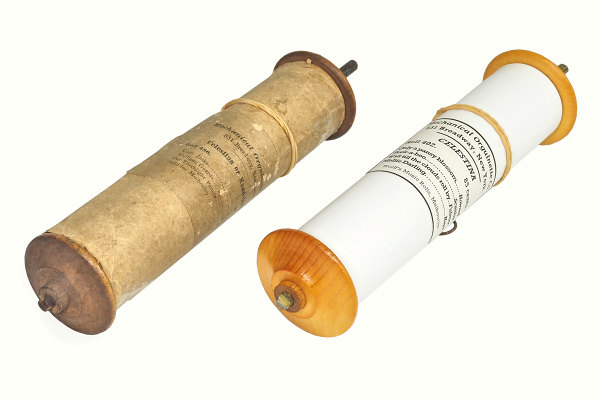 The Celestina music roll
The Celestina music roll
This illustration shows an original Celestina roll from the 1880s
and one of my home-made reproductions. The rolls are wound on wooden
spools about 6" long and 1-1/2" diameter. There is a short half-round
pin at the driving end, and a plain steel pin at the other.
The music that is preserved on these organette rolls gives a window
into what life was like for ordinary folk in the 1880s and 90s.
There were military songs and marches, traditional songs, tunes from
stage shows, comic songs from the music halls, sad songs which
reflected the hardship of the times, and lots of politically incorrect
songs. There were dance tunes, some in long-forgotten styles, for
Saturday entertainment at home, and hymns for church on Sunday. It was
too early to find ragtime or jazz on organette rolls, but the Italian
operas from the 1850s were still very popular, and Gilbert & Sullivan's
were the latest hits.
A typical roll plays for about 3 to 6 minutes. Most "popular"
rolls contain several short tunes of about a minute each. Some hymn
rolls contain multiple verses, while rolls intended for dancing contain
just a single full-length piece. There are a few larger dance rolls
that can play an entire Quadrille in about 10 or 12 minutes.
The prices marked on the original rolls range from about 60 cents
to $1.20, or roughly 20 cents for each minute of music. Tradesmen's
wages at the time were only about 20 cents per hour, so a new roll
could easily cost most of a day's pay.
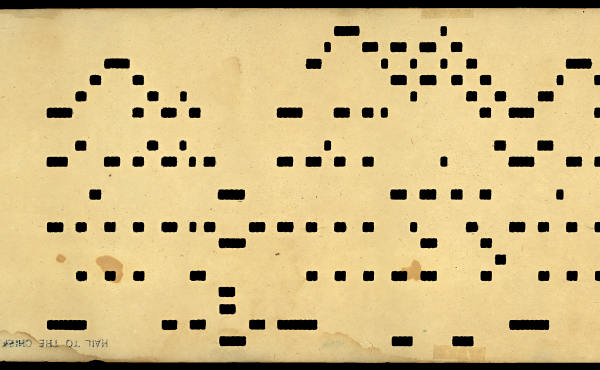 The Celestina tune sheet
The Celestina tune sheet
This illustration shows the beginning of an original Celestina
tune sheet in "piano roll" view, ie, progressing left to right, with
the bass notes at the bottom.
The Celestina plays 20 notes from Ab (G#) to F (MIDI notes 44 to
77), but, like most small organs, it does not have a full chromatic
scale.
The actual notes are:
G# C# D# F# G# A# C C# D D# E F F# G G# A# C C# D# F
or, transposed up 4 semitones:
C F G Bb C D E F F# G Ab A Bb B C D E F G A
The music roll is nominally 5-1/2" wide, with the paper about 1/32"
narrower. The paper is around 0.003" thick, and travels at 5 feet per
minute (1 inch per second). A standard roll spool of 1-1/2" diameter
can hold about 30 feet of paper and play for a maximum of 6 minutes.
The note perforations are arranged on 1/4" centres across the
width of the paper. The punches are 0.150" wide (same as the tracker
bar slot) and 0.095" long. The step advance of the original perforators
was 0.075" (ie, half the slot width), giving an overlap of 0.020" on
continuous slots. The "scallops" between successive punch strikes are
(just) visible in the illustration. This march tune is perforated at
6 punch steps per beat.
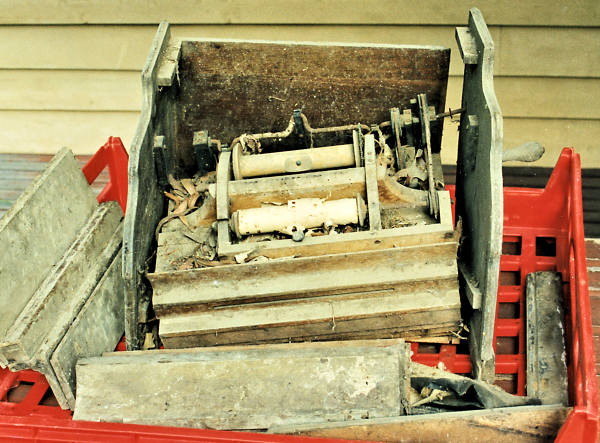 Restoration.
Restoration.
Not all Celestinas have been preserved in the same condition as
the examples above. Although they were treasured posessions in the
1880s, many such instruments were consigned to the barn (or the
bonfire) when their owners "updated" to a gramophone or a radio.
The instrument opposite is shown in the condition in which it was
retrieved from under a house, where it had been stored undisturbed for
more than 50 years. The glued joints have failed, most of the
softwood timber in the mechanism has been destroyed by borers, but
the hardwood case panels are in good condition under all the mud and
leaves. The metal parts (including the reeds) were in good restorable
condition and have cleaned up well. Even the music has been recovered
from the remains of the roll - it was a selection from The Mikado,
which was immensely popular when first produced in 1885. It would have
delighted the owners when this instrument was new.
Construction of an (almost) entirely new mechanism to replace the
borer-damaged components was completed during 2016, and the instrument
is once again delighting its listeners.
Original text and images Copyright © John Wolff 2003-17.
Last Updated: 5 March 2017
Next:
Preserving the Original Music.
Back to:
Home
Mechanical Music
 The 20-note "Celestina" organette was produced by the Munroe Organ
Reed Company and mass-marketed by the Mechanical Orguinette Company
(later The Aeolian Organ and Music Company) during the 1880s and 90s.
The same or similar instruments were produced and sold by several
other companies in the USA and England. In 1885 the Mechanical
Orguinette Company alone sold over 10,000 Celestinas at a list price
of $25 each, or about $2000 in today's money.
The 20-note "Celestina" organette was produced by the Munroe Organ
Reed Company and mass-marketed by the Mechanical Orguinette Company
(later The Aeolian Organ and Music Company) during the 1880s and 90s.
The same or similar instruments were produced and sold by several
other companies in the USA and England. In 1885 the Mechanical
Orguinette Company alone sold over 10,000 Celestinas at a list price
of $25 each, or about $2000 in today's money.
 Celestina with doors open.
Celestina with doors open.
 Celestina decoration 1.
Celestina decoration 1.
 Celestina decoration 2.
Celestina decoration 2.
 Celestina decoration 3.
Celestina decoration 3.
 Celestina mechanism - front view
Celestina mechanism - front view
 Celestina reed block and reeds
Celestina reed block and reeds
 Celestina mechanism - rear view
Celestina mechanism - rear view
 Inside the Celestina windchest.
Inside the Celestina windchest.
 The Celestina music roll
The Celestina music roll
 The Celestina tune sheet
The Celestina tune sheet
 Restoration.
Restoration.